North to Alaska
The plane would leave at 9:30 p.m., meaning we needed to schedule the airport transport to arrive no later than 7:30. It was an hour drive to catch that ride, so working back, I figured out my lunch time, packing car and then, getting my husband “on board” with the plan. Catching a plane is not negotiable. It just is.
Surprisingly, he was already out at his car as I rolled my carry-on suitcase over the sidewalk at the appointed time. But what is this? He is on his knees? Looking under the car? NO! A flat tire!
I had no time nor patience to put on the “donut” and take off for an hour’s drive, leaving a chore hanging over our heads for the next three weeks.
“Put your stuff in my car!” I barked. “I’m getting my keys!” There was no time to waste.
Fifteen minutes later, literally cruising down the highway, a passing motorist cut in front of me, evidently engaging my automatic braking, setting off buzzers and a dash message flashing: Malfunction! What next? Perseverance!
Thus began our “North to Alaska” adventure . . . a shaky start, but at least didn’t involve dog sled upkeep, becoming a “moose statistic” nor the Arctic’s winter. This outlook on life falls under the little Midwestern game called: It Could Be Worse, a continual comparison of what is and/or could have been, everything being relative.
For instance, the Northern Lights seen from the plane were more breathtaking, if possible, than those seen from the ground.
Hiking was put into perspective when my nephew, Jake, strapped on his handgun for the backcountry excursion in the Russian River area. Jake, a teacher by trade, is an Alaskan Fishing guide in season. What he says to do in the bush, you do!
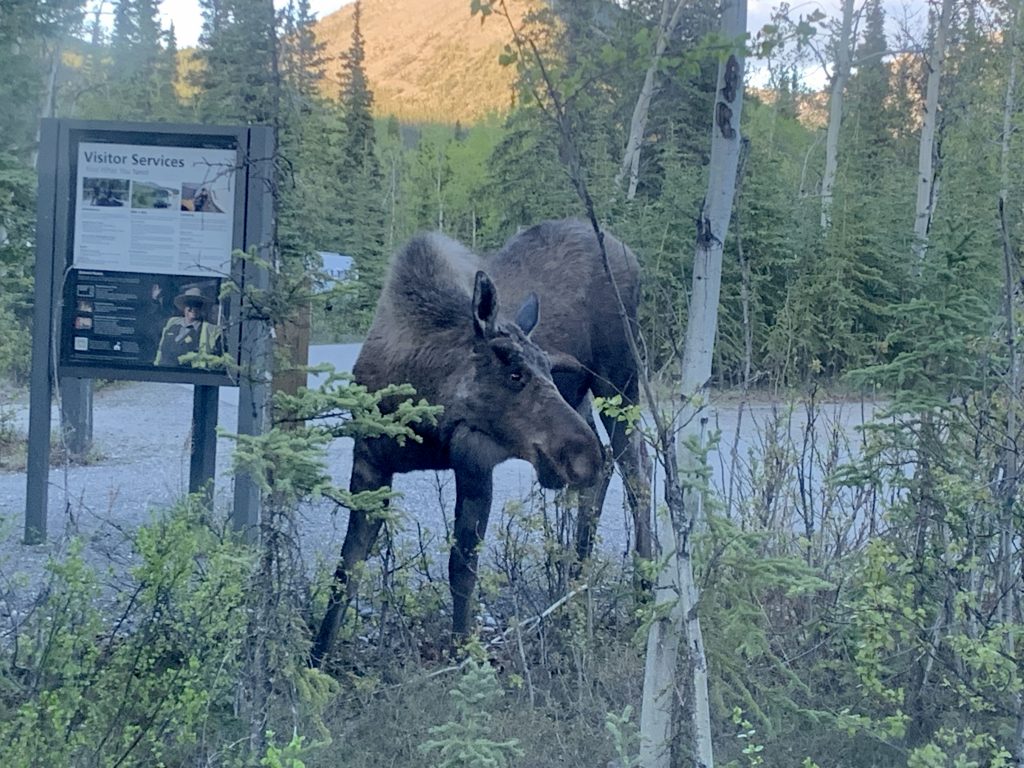
The Denali bus driver was precise about “when to hold them (fight back), when to fold them (play dead), and when to run” referring to the black or brown bear and moose. I preferred my bear at the far end of the binoculars, but appreciated the moose grazing her way up to our parked car that evening as we made camp.
Being springtime, baby animals were trying out their wobbly legs with their very protective mothers in sight. Tom and Jeanie advised us to look carefully when exiting their Homer abode. They spent 15 years planting vegetation, opening the silty creek and fencing gardens on their property. One morning, Tom whispered for us to follow him, pointing out a Mama moose and baby, perhaps four days old, sunning themselves by the back bench.
In Seldovia, high school friend, Dolly and her husband, Ken, led us along the Otterbahn trail to Outside beach, where most animals were two-legged hikers. Growing up, I was taught to walk quietly, a toe to heel step, leaving spaces between walkers to prevent twigs from snapping back in their faces. Here, we stayed clumped up and chattered on, so as not to surprise a bear, but scare it away prematurely.
How fortunate to have friends and family opening their homes and lives to us as we plotted our path on the map from Anchorage to Homer to Seldovia and then up to Fairbanks via Denali and back on the Richardson highway to Anchorage again. Whew! Exploring without guidance is an adventure, but being led to favorite trails, river campgrounds and community feeds made adventuring more relaxed. Having people “who know stuff” answer our questions and give pointers smoothed the way.
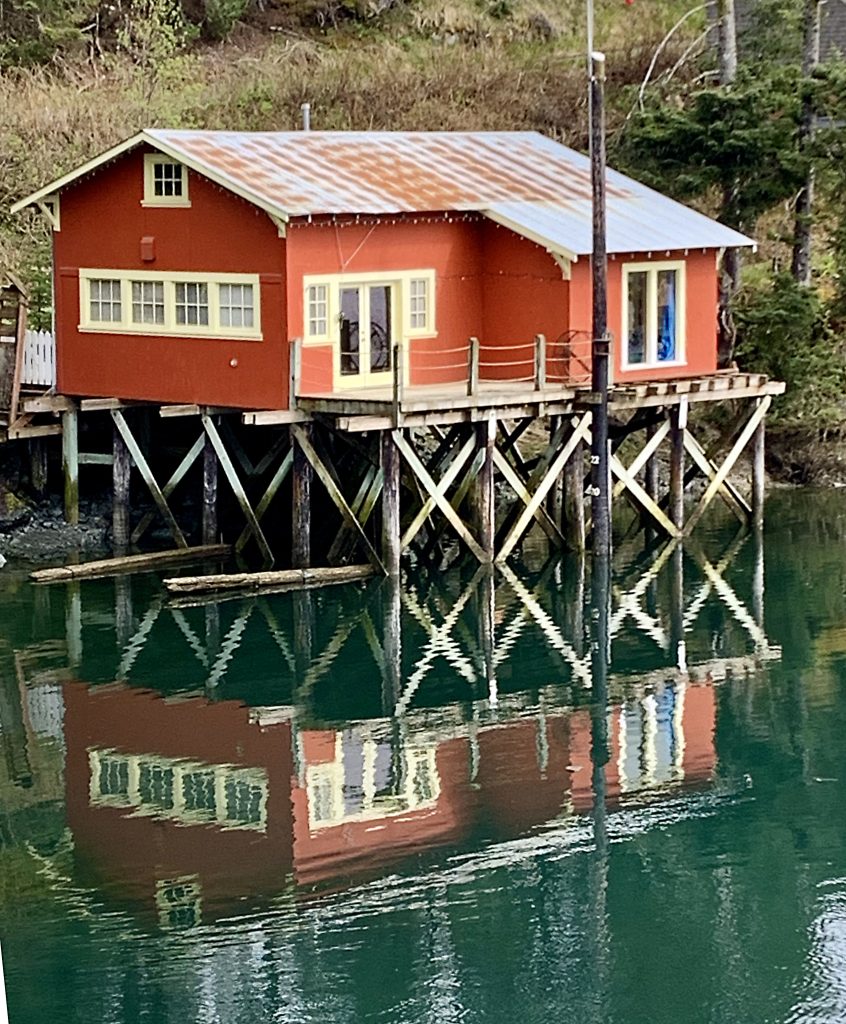
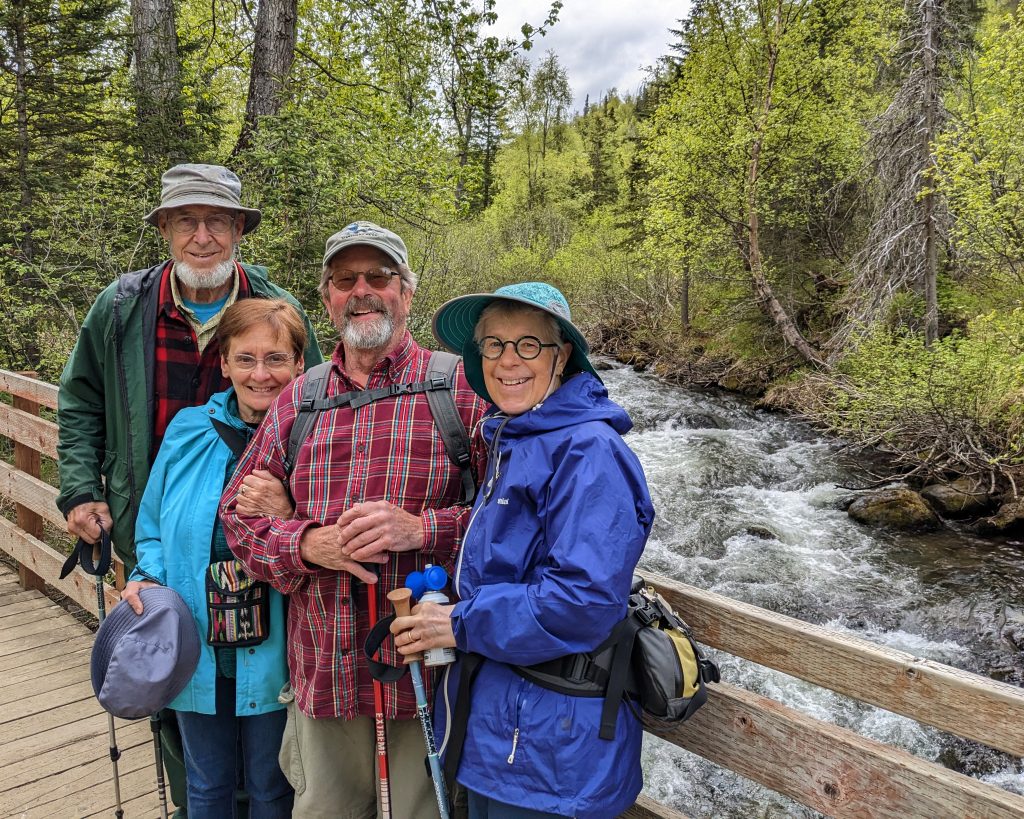
It was a lesson in flexibility and intentional living. The rental car had a broken back seat that wouldn’t fold down for sleeping, the plan for our week of camping. It took an hour, but a car fitting our request was returned, quickly being set up for our “better late than never” departure. Choices included fretting or accepting.
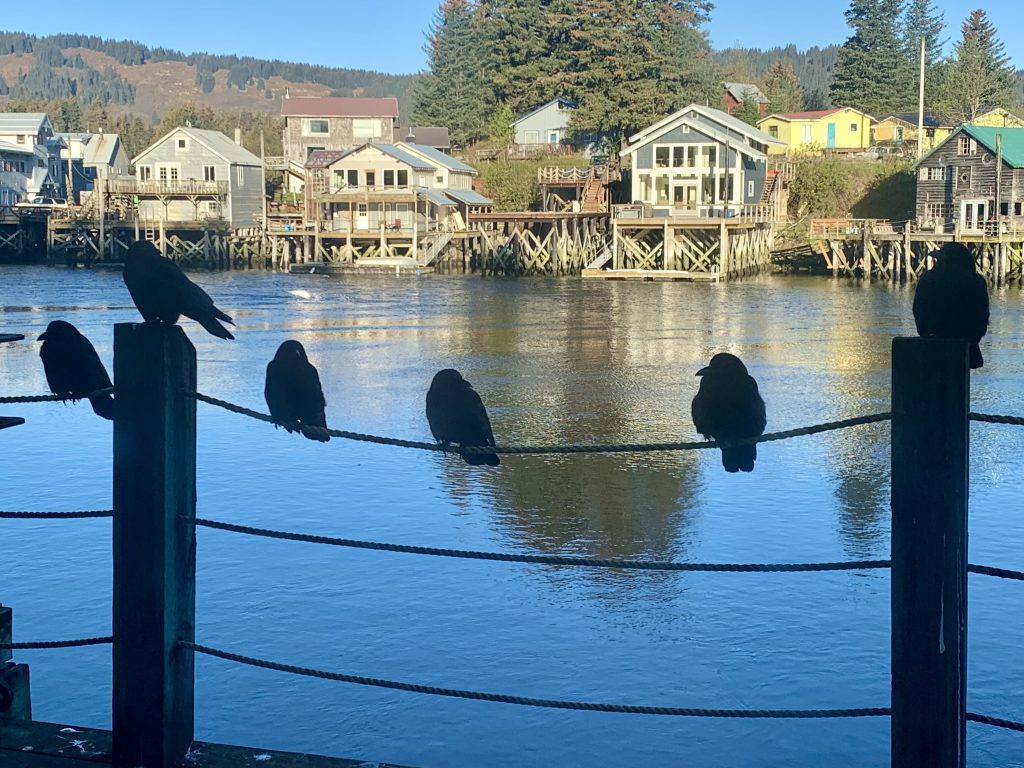
Maybe that very delay was repaid later when we rounded the mountain and saw the clouds lift over Denali, revealing its majestic peak. We became part of a group called “The 30 Percenters,” a term for the amount of people that actually get to see Denali in full. The weather continued clear and warm for the trip to Fairbanks, where my Siri search unearthed the Abbey Arch Inn, an eclectic spot run by an energizer bunny woman who ended each sentence with a laugh.
This marvel was the receptionist, housekeeping director, information guide, dispensed $10 worth of quarters for the laundry if you called her, and was chief cook and bottle washer for a full American breakfast. That means Egg casserole (Egg bake in my neighborhood), waffles, toast, berry jams, cereals, sausages, fresh muffins and breakfast juices – all you can eat. After three nights camping in the back of a Sienna, the king bed, laundry, jacuzzi and hot meal were a dream. And, I note, all for $140.00 in a land of $250 to $400 a night at chain accommodations.
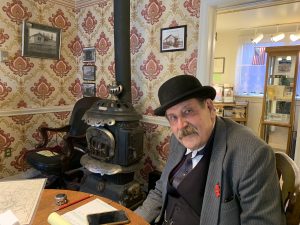 It did rain enough that afternoon to clear out Pioneer Park of a raft of families with children letting off hours of pent-up energy. We took shelter in Judge James Wickersham’s house museum to wait it out and had a “small world” encounter. The gentleman guide, dressed in period clothing, asked if we wanted stories on the Judge and his place in history. Yes, please.
It did rain enough that afternoon to clear out Pioneer Park of a raft of families with children letting off hours of pent-up energy. We took shelter in Judge James Wickersham’s house museum to wait it out and had a “small world” encounter. The gentleman guide, dressed in period clothing, asked if we wanted stories on the Judge and his place in history. Yes, please.
One subject led to another until we uncovered mutual friends in Eau Claire, Wisconsin. In fact, Stephen Mitchell was related to the Barnes and the Arnold families, both part of my life growing up in the First Congregational Church where my dad had been a pastor. Each exclamation of name recognition led to another memory that united our paths. I texted his photo to our mutual connections back in Wisconsin, completing the circle.
Despite my promise not to be a photo opportunist, I return with a collection of mountains, river rapids, glimpses of glaciers, and the moose. Many memories are a blur of scenery out the window. Others include the Seldovia fishing contest feed, where a 12-year-old boy won a double kayak while we wolfed down halibut and potluck delights in the town park shelter. The scrumptious tastes of salmon and moose served by our friends linger. As to feasting, we visited Jake’s science classroom in Nikiski, where his 160th (or was it 180th) generation of fruit flies are fed to his exotic blue and yellow frogs living in his self-developed and contained eco-system. His students fortunate to have this incredible, enthusiastic teacher!
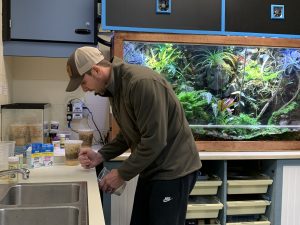
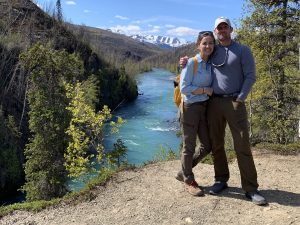
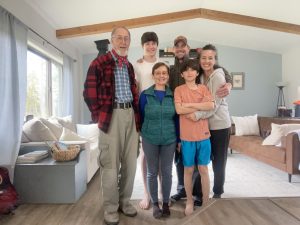
I’d like to introduce you to Jeanie Aspen and Tom Irons, good friends and long-time adventurers in Alaska. If you are interested in true stories of perseverance check their website https://jeanaspen.com/
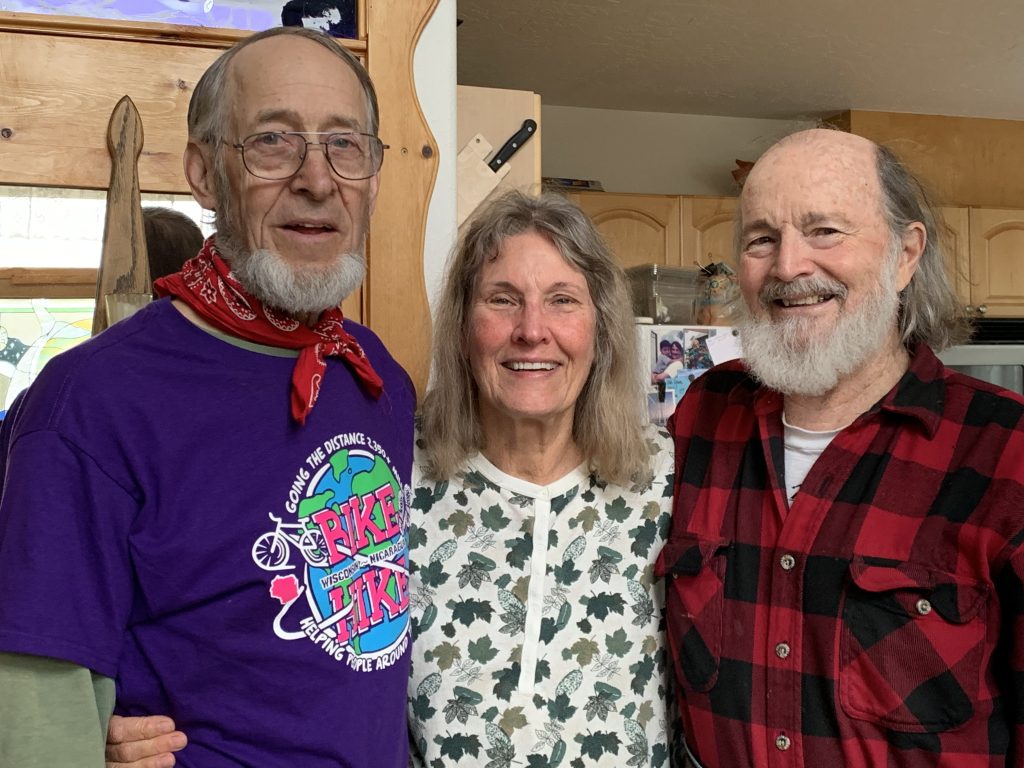
Take a peek at the trailers for their 3 documentaries
- Arctic Son: Fulfilling the Dream
- Arctic Daughter: A Lifetime of Wilderness
- ReWilding Kernwood
Full documentaries are available for streaming through PBS.
What’s YOUR story of perseverance?
Share your experience in the comments section below.

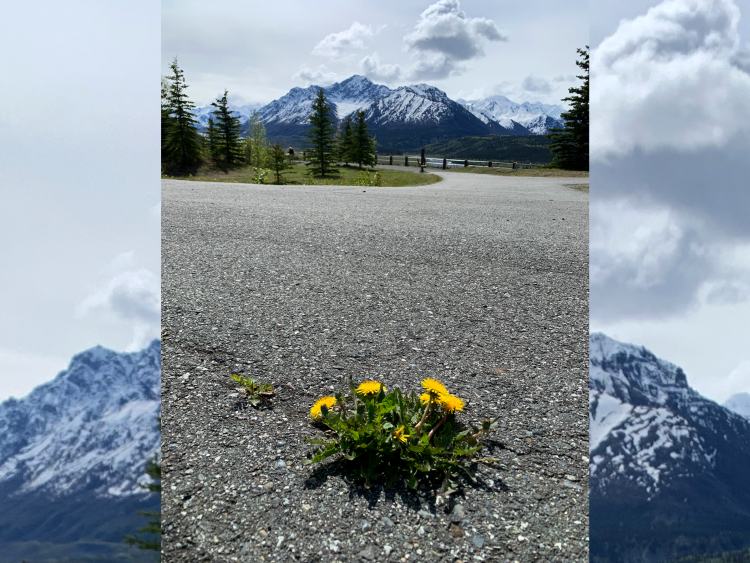
What a great adventure…and an amusing and enriching account…Thanks for sharing and Happy Trails my friend
Thanks, Carla, for coming along with me on the road. Hope that we WILL soon be on the road soon together.
We had one trip to Seldovia and a good experience there. Incredible tides
Gracias, Ricardo, for sharing your adventures of Alaska before I left on my trip. It raised my enthusiasm.
Thank you for once again sharing your travels – and your intriguing thoughts – with us! You are a treasure and a WONDER!!
Lauren, Having your feedback is always reassuring and encourages me on in travel and in writing.
Great account of your adventure. I could feel myself standing right next to you kids as you told your great stories. Thanks. Welcome home.
Darrell, You are the expert in story telling, so now I’m going to tell everyone to go out and get your book, “Campfire in the Basement” – available at https://darrelljpedersen.com/
What an incredible opportunity to not only see Denali but to experience the culture, weather and family. Loved reading about the trip. Thank you.
Jan, we got to Hawaii this summer, and it was great fun. Alaska is in our sights soon – top of the bucket list. Your blog makes me even more excited to go. Thanks!
Great to hear from you! Did you know Dolly from high school days!? Great to see her and get Alaska. Travel on!!!